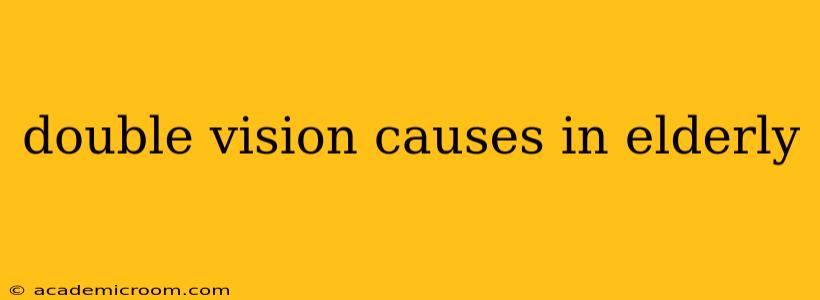Double vision, also known as diplopia, is a common complaint among older adults, significantly impacting their quality of life. Understanding the causes is crucial for timely diagnosis and effective management. While numerous factors can contribute to double vision in the elderly, many are treatable. This guide explores the most common causes, offering insights to help both individuals and healthcare providers.
What are the Most Common Causes of Double Vision in Elderly People?
Several conditions can lead to double vision in older individuals. These often relate to age-related changes in the eyes and nervous system. Some of the most frequent causes include:
-
Eye Muscle Weakness (Myasthenia Gravis): This autoimmune disorder affects the muscles that control eye movement, leading to double vision, often fluctuating in severity throughout the day. It's more prevalent in older adults and can be accompanied by other symptoms like muscle weakness elsewhere in the body.
-
Stroke: A stroke disrupts blood flow to the brain, potentially damaging areas responsible for eye movement control. Double vision is a common symptom, often appearing alongside other neurological deficits. The location and severity of the stroke influence the extent of vision problems.
-
Diabetes: Long-term diabetes can damage the nerves controlling eye muscles (diabetic neuropathy) or cause other eye problems like cataracts or glaucoma, which can indirectly lead to double vision. Careful blood sugar control is vital in mitigating these risks.
-
Multiple Sclerosis (MS): This autoimmune disease affects the brain and spinal cord, interfering with nerve signals to the eye muscles. Double vision is a hallmark symptom of MS, often appearing early in the disease progression.
-
Brain Tumors: Tumors pressing on the nerves controlling eye movement can cause double vision. The location and size of the tumor influence the symptoms.
-
Head Injuries: Trauma to the head can damage the eye muscles or the nerves that control them, resulting in double vision. Severity depends on the extent of the injury.
-
Eye Diseases: Conditions like cataracts, glaucoma, and macular degeneration can affect vision and, in some cases, indirectly contribute to double vision by impacting depth perception or visual clarity.
What Other Questions Do People Often Ask About Double Vision?
Let's address some frequently asked questions surrounding double vision in the elderly:
How is Double Vision Diagnosed in Older Adults?
Diagnosis typically involves a thorough eye examination, including a comprehensive assessment of eye muscle function and visual acuity. Neurological testing may be necessary to rule out underlying conditions affecting the brain or nervous system. Imaging techniques like MRI or CT scans can help identify structural abnormalities such as brain tumors or stroke damage.
Can Double Vision Be Treated in Elderly Patients?
Treatment depends on the underlying cause. Some conditions, such as eye muscle weakness from myasthenia gravis, may respond to medication. Others, like stroke-related double vision, may require rehabilitation to improve eye muscle control. In cases caused by eye diseases, treatment focuses on managing the underlying condition. Surgery might be considered in specific circumstances, such as correcting eye muscle misalignment (strabismus).
When Should I Seek Medical Attention for Double Vision?
Double vision should not be ignored. If you or a loved one experiences sudden or persistent double vision, seek immediate medical attention. Prompt diagnosis and treatment can prevent further complications and improve the overall quality of life.
Are there any Home Remedies for Double Vision?
While there are no home remedies to cure double vision, maintaining good eye health practices, like regular eye exams and managing underlying conditions like diabetes, can help prevent its onset or slow its progression. Eye exercises prescribed by an ophthalmologist might improve eye muscle control.
What are the Long-Term Effects of Untreated Double Vision?
Untreated double vision can lead to a decline in visual function, making everyday tasks challenging. It can also impact balance, coordination, and depth perception, increasing the risk of falls and injuries. Moreover, the underlying condition causing the double vision might progress, leading to more severe consequences.
Conclusion
Double vision in elderly individuals requires a comprehensive evaluation to determine the underlying cause. Early diagnosis and appropriate treatment are vital for managing this condition effectively and improving the patient’s quality of life. Consult an ophthalmologist or neurologist promptly for any concerns regarding double vision. Remember, proactive healthcare can make a significant difference.
